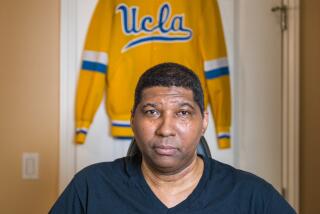Tennis Great Laver Rallies From Stroke
- Share via
RANCHO MIRAGE — Rod Laver’s right foot was completely numb, so moving it presented a problem. Finally, he got the message through to his foot and there he went, taking a step.
But only one step.
“‘For a little while, I was really battling with that; I could think ‘Move,’ but it wouldn’t move,” the tennis great said, recalling his recovery from a stroke that initially paralyzed his right side.
“Somehow, my brain finally seemed to will it to move. Bit by bit, it moved automatically. But then it didn’t know what to do after one step. Of course, after you make one step, you’ve got to make two or three more,” Laver said, laughing. “But finally it all worked.”
The 62-year-old Laver, the only player to win the Grand Slam of tennis twice, has made great strides since his stroke in July 1998.
The left-hander from Australia walks with a barely perceptible limp, but his speech is unaffected, he plays golf and--extremely important to him--he plays a lot of tennis.
“I’m fine,” he said in a recent interview. “I’m 100 percent for everyday things; there’s nothing that’s a problem now. It’s just that some of my right side is a little numb and the feeling may never come back.”
Laver suffered the stroke during the taping of a television interview. Fortunately for him, the studio was less than a mile from UCLA Medical Center.
“I really didn’t know what was happening to me,” he said. “I’m lucky the hospital was so close.”
Doctors initially thought he would remain hospitalized for months. But he went home after a month, and two months after the stroke, he was back on the tennis court.
“The doctors were surprised. At first, I couldn’t move my right side at all. They asked me to do things like touch my fingers together, and I couldn’t do it. Then suddenly, I could,” he said.
That was a start on the way back.
“I was in a wheelchair for about two months, couldn’t stand up,” he said. “All of a sudden, I said, ‘I can do this.’ The doctors asked me what made me a tennis champion, and I told them it was energy and concentration, over a 10- or 20-year period.
“Then I related that to what I needed to do to be physically well again and I thought, ‘I’m going to beat this thing. I know what I did in my life as a tennis player.’ ”
Determined, he took to the task.
‘I worked with a speech therapist, did physical therapy, those things that you just have to accept and do,” Laver said. “I think acceptance of it is some of what you have to go through. You have to realize it’s a slow process and it’s not like it’s going to happen tomorrow morning.”
He credits his doctors and his family with helping him recover from the stroke. A lifetime love of his also provided incentive.
“Tennis, that’s been the thing,” said the man who won the Australian Open, the U.S. Open, the French Open and Wimbledon as an amateur in 1962 and swept the Grand Slam tournaments again as a professional seven years later.
“I told the doctors that I would love to get back on the court, even if they had to drag me out there. They told me that maybe I would be able to play some again.”
Laver began hitting with his son, Rick, and kept steadily increasing his playing time.
“I found I could always put my left foot down and move off it. But I didn’t get too excited about running somewhere to hit the ball,” Laver said.
The player whose powerful forehands and backhands earned him the nickname, “The Rocket” still can zip the ball.
“I was out hitting with a friend and she said, ‘Hey, you can’t hit this hard. You’re not allowed to do this.’ That helps, when I hear things like that,” Laver said.
More to Read
Go beyond the scoreboard
Get the latest on L.A.'s teams in the daily Sports Report newsletter.
You may occasionally receive promotional content from the Los Angeles Times.










